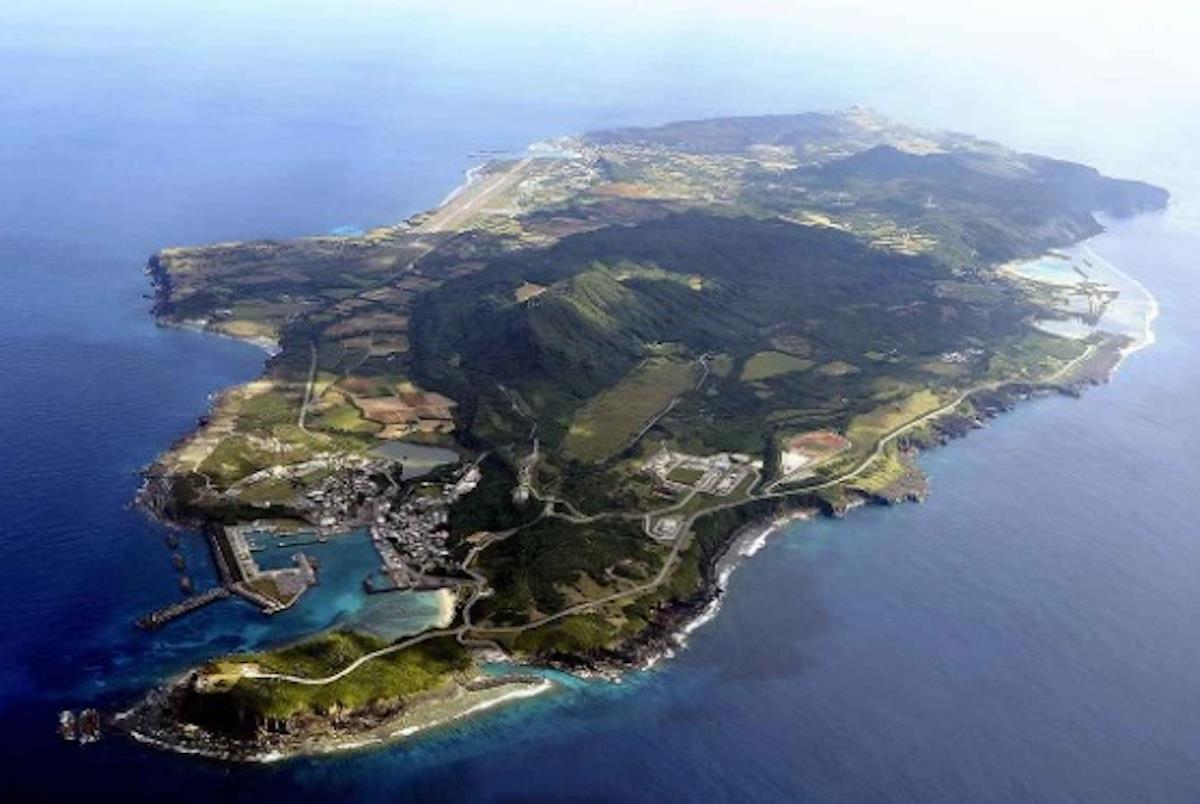
Japan's Yonaguni Arming Up For A Taiwan War With China
This month, Naval News reported that the US Marine Corps has ramped up operations on Yonaguni Island, Japan's westernmost outpost just 112 kilometers from Taiwan, as part of its First Island Chain strategy aimed at bolstering regional deterrence.
Since September 2025, US Marines have conducted multiple logistics missions, offloading containers of medical supplies, disaster response equipment and refrigeration units at Kubura Port during exercises tied to Resolute Dragon 2025.
The deployments, coordinated with Japan's Self-Defense Forces (JSDF), included establishing a Forward Arming and Refueling Point (FARP) this October, marking the first time CH-53E heavy-lift helicopters operated that far southwest in Japan.
US officials emphasize humanitarian assistance and disaster relief as the stated rationale but the island's proximity to Taiwan and its infrastructure of ports and runways make it strategically vital for rapid reinforcement or denial operations against China.
A second barge mission concluded in November, underscoring the sustained activity. The moves come amid heightened tensions, with Japan scrambling F-15Js after a Chinese drone flew near Yonaguni last week.
Yonaguni Island is crucial for US military strategy, positioned on China's“First Island Defense Line” and along the maritime route between Taiwan and the East China Sea. Located just 112 kilometers from Taiwan, it serves as a key point for surveillance, anti-access measures and potential joint operations between the US and Japan during crises in the Taiwan Strait.
The strategic island can host US missile systems, anti-submarine capabilities and serve as a staging ground for US and Japanese operations during a Taiwan contingency.
The island's small size – just 28 square kilometers – may preclude the deployment of large, multi-vehicle systems such as the US Typhon, armed with Tomahawk cruise missiles with a 2,000-kilometer range.
Latest stories
Weakest president in a century capitulates to America's old foe

Zelensky running out of time with Trump peace plan on the table
Such systems might be limited by their reliance on strong road and bridge infrastructure and support facilities, which could be scarce in austere locations. That shortage of suitable infrastructure may limit possible movement and deployment locations, making them easy to locate and destroy.
Instead, US missile deployments on Yonaguni could feature smaller, shorter-ranged systems such as the Navy-Marine Expeditionary Ship Interdiction System (NMESIS), which could hit targets 185 kilometers away. NMESIS is compact and nimble enough to operate in a small, austere island environment such as Batanes in the northern Philippines or Yonaguni in Japan.
NMESIS missile systems stationed at Yonaguni could cover the Miyako Strait – a critical chokepoint that China's warships have to cross to break into the open Pacific. It could also cover possible amphibious landing sites in northern Taiwan, near Taipei.
Yonaguni is also a key node in the US “Fish Hook” underwater sensor network that runs along the First Island Chain. One section is known to start at the Senkaku Islands, which China contests with Japan, and extends 150 kilometers to Yonaguni.
Given the vulnerability of surface ships to missile attack, China may opt to use submarines to cross the Miyako Strait to blockade Taiwan and interdict US and allied forces in a conflict scenario.
While US and allied anti-submarine forces may attempt to interdict China's submarines crossing the Miyako Strait, China's submarines may compensate for that with sheer numbers.
According to the US Department of Defense's (DoD) 2024 China Military Power Report (CMPR), China has 48 conventionally-powered submarines – a substantial fleet.
Detailing China's conventional submarine production capability, Sarah Kirchberger mentions in a September 2023 China Maritime Studies Institute (CMSI) report that several Type 039A Yuan-class submarines under construction have been observed at the Wuchang Shipyard in Wuhan, suggesting a true mass-production line with capacity exceeding many foreign submarine yards.
Kirchberger also notes that Jiangnan Shipyard at Shanghai builds conventional submarines in parallel with Wuchang, including newer variants such as the Type 039C.
She notes that this multi-yard, high-throughput model-supported by upgraded infrastructure and modern modular construction-gives China one of the world's highest-volume conventional submarine production systems.
That means, even if the US and its allies manage to intercept some Chinese submarines trying to break out into the open Pacific, possibly many more would be able to escape the US's anti-submarine gauntlet to blockade Taiwan and interdict US and allied forces.
Beyond serving as a missile base and submarine sensor node, Yonaguni can also serve as a staging area for US forces, should the US face a scenario where it bids to retake Taiwan from China.
Jacqueline Schneider mentions in a November 2021 War on the Rocks article that if China wins the initial high-tech struggle for air and sea control, US forces could be compelled to attempt retaking Taiwan.
Schnider says that such an operation would resemble World War II island campaigns, demanding mass landings and attrition against the world's largest army. However, she points out that historical analogies, such as the US re-invasion of the Philippines, in which the former lost 23,000 lives, highlight the risks.
Beyond the constraints and risks posed by Yonaguni's small size, China's massive conventional submarine production, and a possible US counter-invasion of Taiwan, the island itself may be vulnerable to attack, weakening its value as a forward position and key sensor node.

Sign up for one of our free newsletters
-
The Daily Report
Start your day right with Asia Times' top stories
AT Weekly Report
A weekly roundup of Asia Times' most-read stories
In a September 2025 report for the Center for a New American Security (CNAS), Stacie Pettyjohn and Molly Campbell note that tabletop exercises simulating a Chinese drone swarm attack on Yonaguni, while not outright destroying US forces, could compel the latter to take a defensive stance.
Pettyjohn and Campbell note that sustained Chinese drone swarm attacks could deplete US interceptor stockpiles, leaving US forces on the island exposed to attack.
Beyond the drone swarm threat, Yonaguni's lack of hardened infrastructure could pose a vulnerability to US forces on the island, with only one civilian airport available.
Kelly Grieco and other writers mention in a December 2024 Stimson Center report that Chinese missile salvos could shut down runways for days or even weeks, preventing fighters, bombers and especially tankers from launching or recovering, thereby paralyzing sortie generation at the outset of a conflict.
Furthermore, Thomas Shugart III and Timothy Walton point out in a January 2025 Hudson Institute report that vulnerability is magnified by the US's limited investment in hardened shelters, redundant runways and passive defenses. Shugart and Walton warn that China could cripple US airpower on the ground and be incentivized to strike first in a crisis.
While Yonaguni improves US and Japanese reach into the Taiwan Strait and the Miyako Strait, its austere infrastructure and physical fragility would limit its usefulness in a prolonged fight. China's growing strike, drone and submarine capacity means the island could become a liability as much as an asset once a conflict begins.
That leaves Yonaguni as both a forward asset and an exposed liability - a position whose loss could ripple across the First Island Chain at the first salvo.
Sign up here to comment on Asia Times stories Or Sign in to an existing accounThank you for registering!
An account was already registered with this email. Please check your inbox for an authentication link.
-
Click to share on X (Opens in new window)
Click to share on LinkedIn (Opens in new window)
LinkedI
Click to share on Facebook (Opens in new window)
Faceboo
Click to share on WhatsApp (Opens in new window)
WhatsAp
Click to share on Reddit (Opens in new window)
Reddi
Click to email a link to a friend (Opens in new window)
Emai
Click to print (Opens in new window)
Prin

Legal Disclaimer:
MENAFN provides the
information “as is” without warranty of any kind. We do not accept
any responsibility or liability for the accuracy, content, images,
videos, licenses, completeness, legality, or reliability of the information
contained in this article. If you have any complaints or copyright
issues related to this article, kindly contact the provider above.


















Comments
No comment